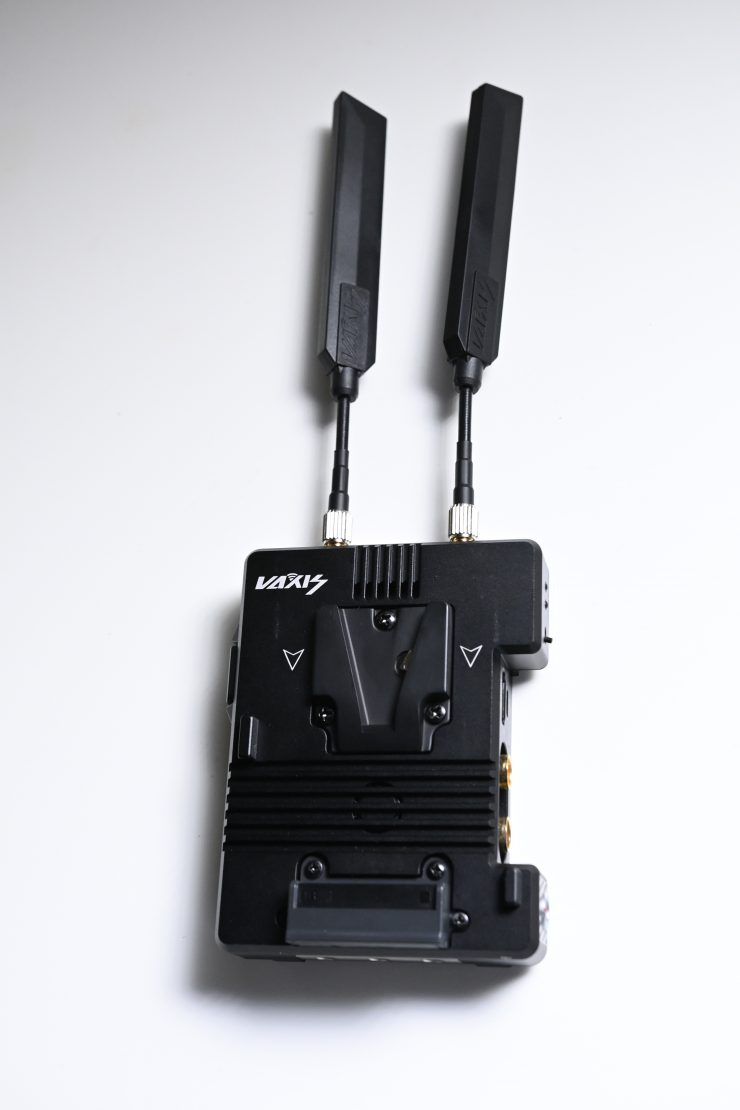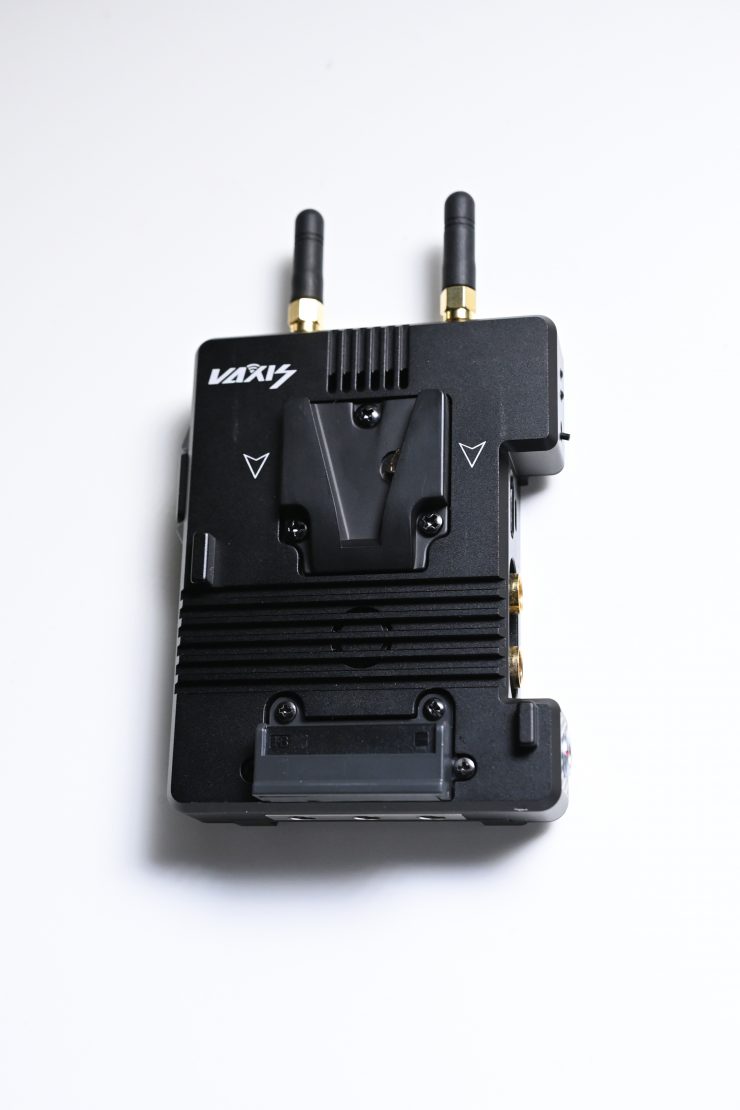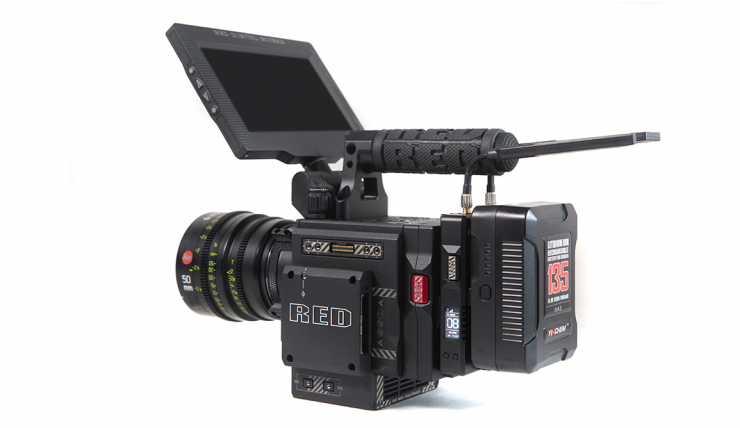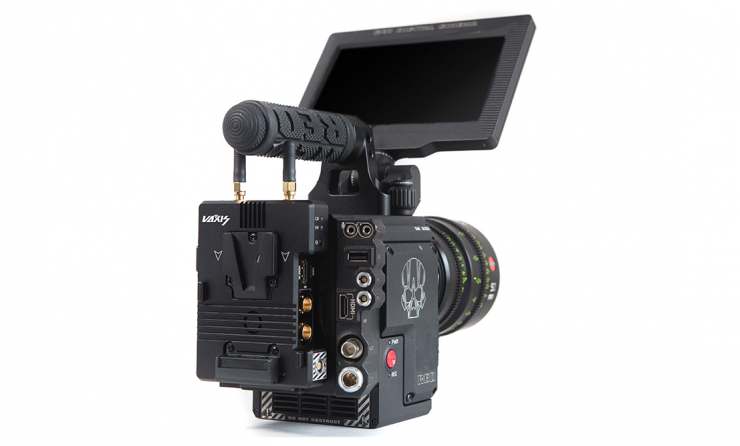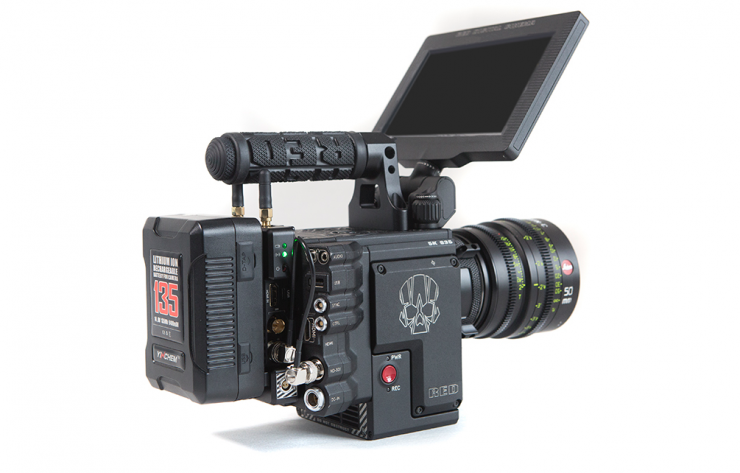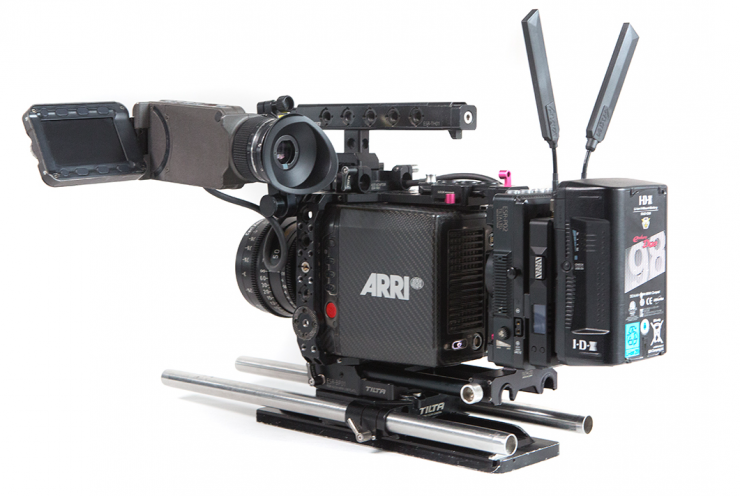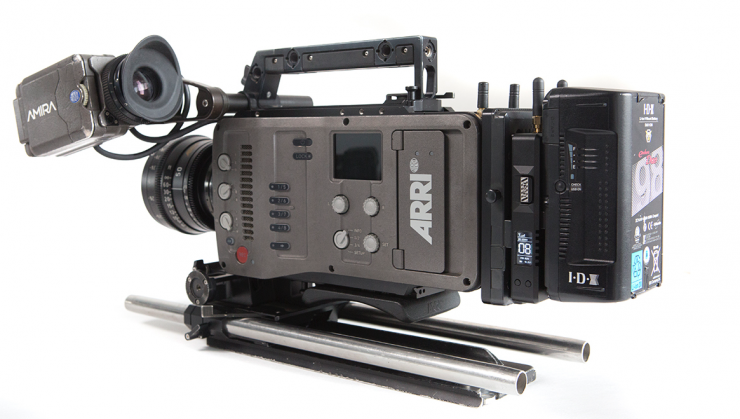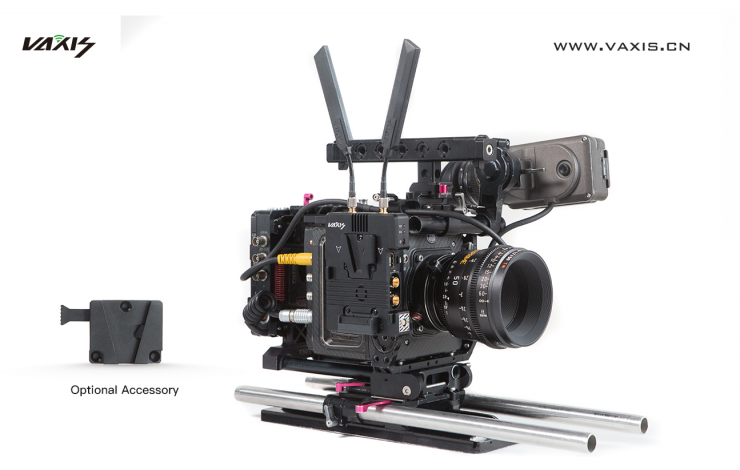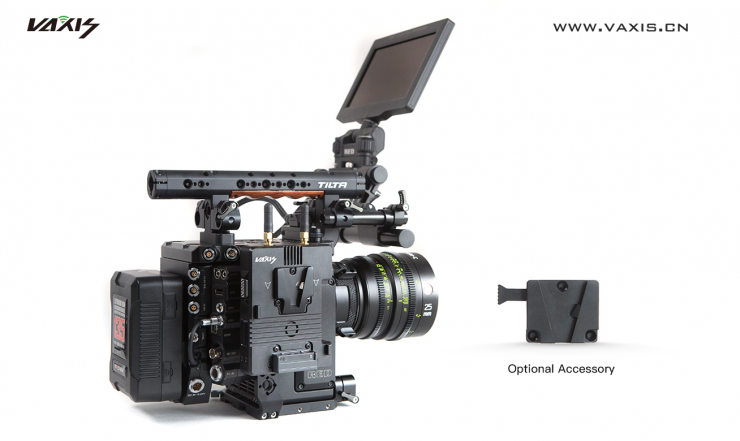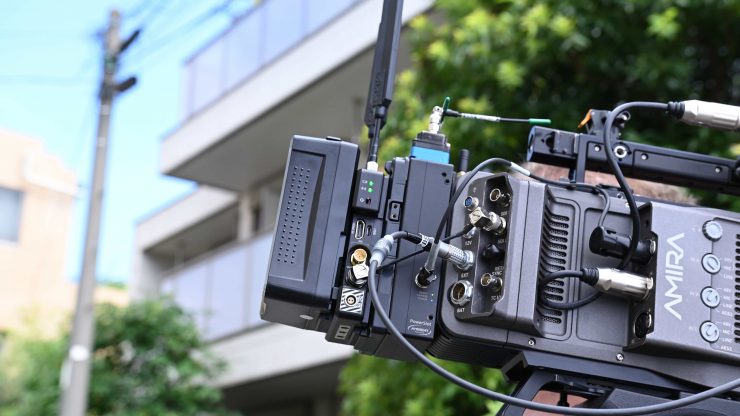
We first saw the Vaxis Storm 3000 Dual V-lock TX at NAB earlier in the year. It looked like an interesting product so I thought it was a good idea to put it through its paces and see how it performs and works.
Key features
- Full HD 1080p, no compression, zero delay.
- Transmission 3000ft
- Channel Scanner workable
- LED screen
- USB upgradeable
- TX: SDI In x1 & HDMI In x1, SDI loop out
- Built-In HDMI/SDI Converter
- Support metadata, timecode, and time trigger
- Zero delay for Arri Mini playback, on/off optional
- Dual V mount on TX
- Compatible with ALL Vaxis Storm Wireless Receivers.
Concept
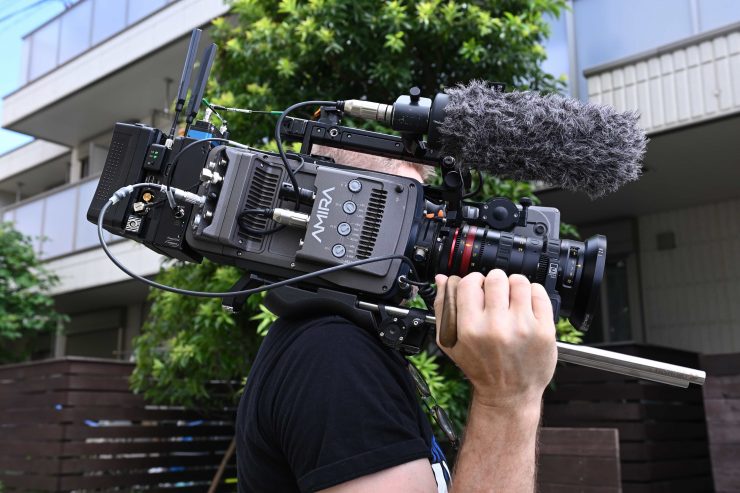
The wireless TX is designed to sandwich between a camera body with a V-lock battery plate (or any other V-lock battery plate) and a battery. There is also a version that comes in Anton Bauer Gold Mount.
The concept behind this is to create a more integrated wireless transmission system that becomes more a part of the camera, than an add on accessory.
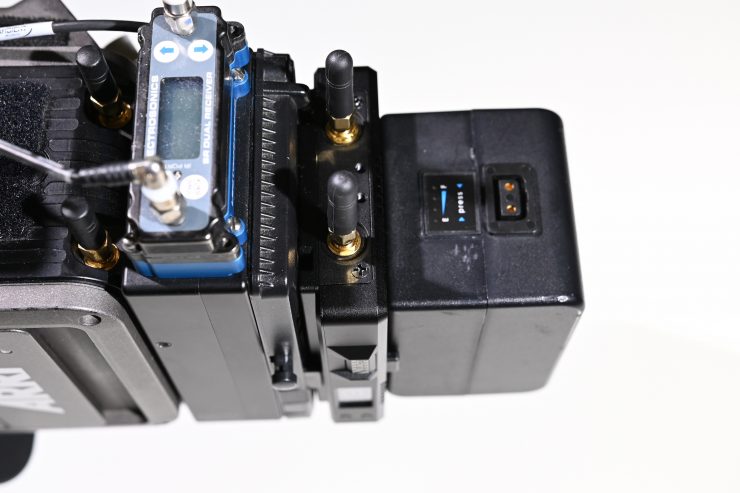
If you are going to put a wireless transmitter on your camera then you might as well try and seamlessly integrate it, rather than have it hanging off the side of your camera.
We are all looking to create cleaner camera builds with fewer cables and parts, the Vaxis Storm 3000 Dual V-lock TX is just one product that goes some way towards achieving that goal.
Build Quality
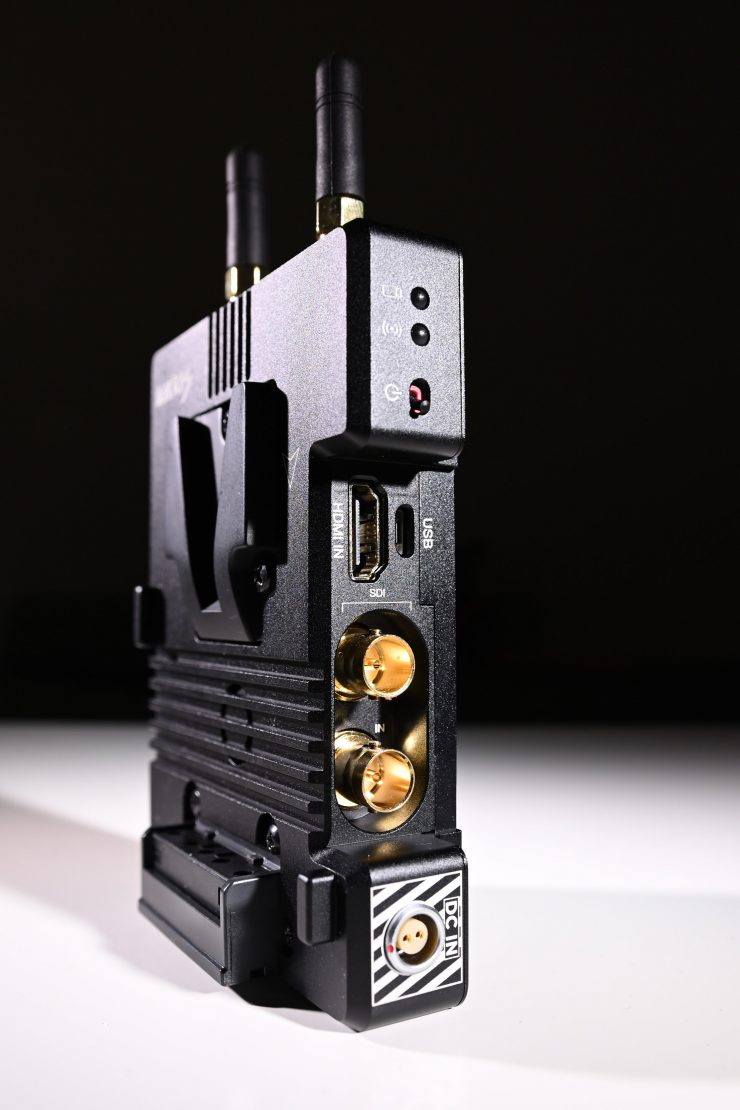
I have reviewed quite a few Vaxis products over the years, and their build quality continues to improve. The Storm 3000 Dual V-lock TX is solidly constructed and well made.
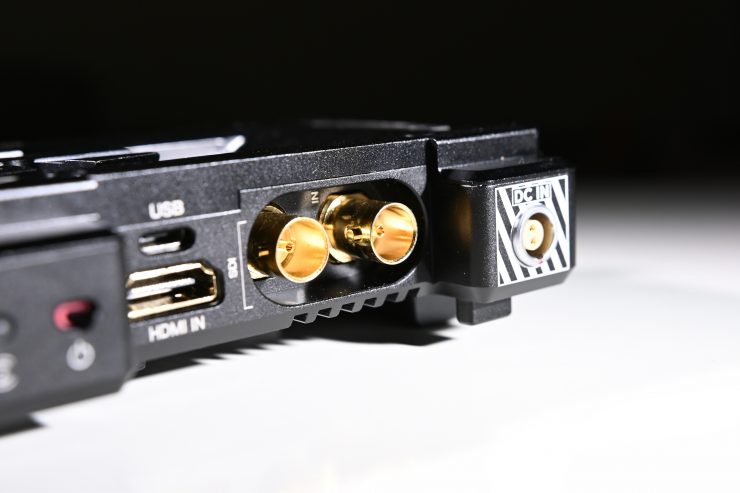
What I like is Vaxis have now countersunk the SDI ports into the body of the transmitter and receiver. This is a nice move because it offers a lot more protection for the cables.
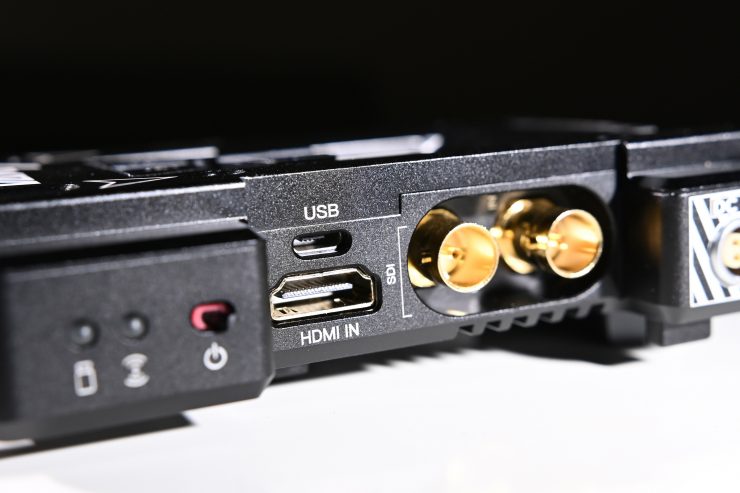
The HDMI and the USB ports aren’t countersunk, but the design of the TX unit still provides them with some protection.
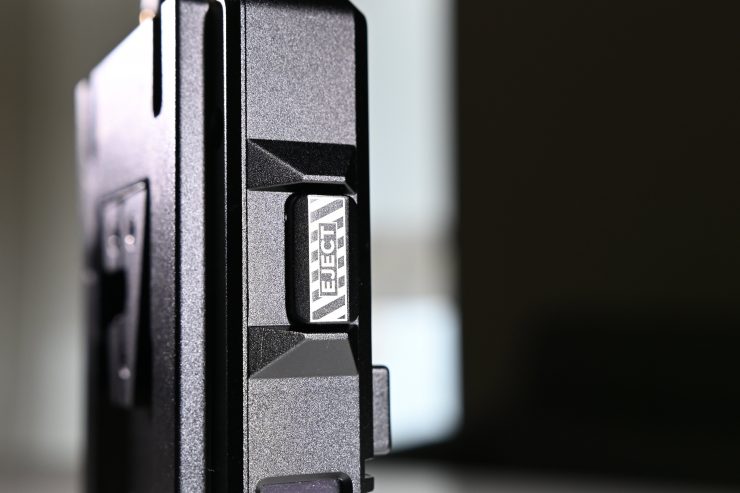
Personally, I think the Eject button to release a V-mount battery is a little gimmicky.
The Storm 3000 Dual V-lock TX snaps on securely onto V-lock plates and there isn’t any wobble or movement.
Size & Weight
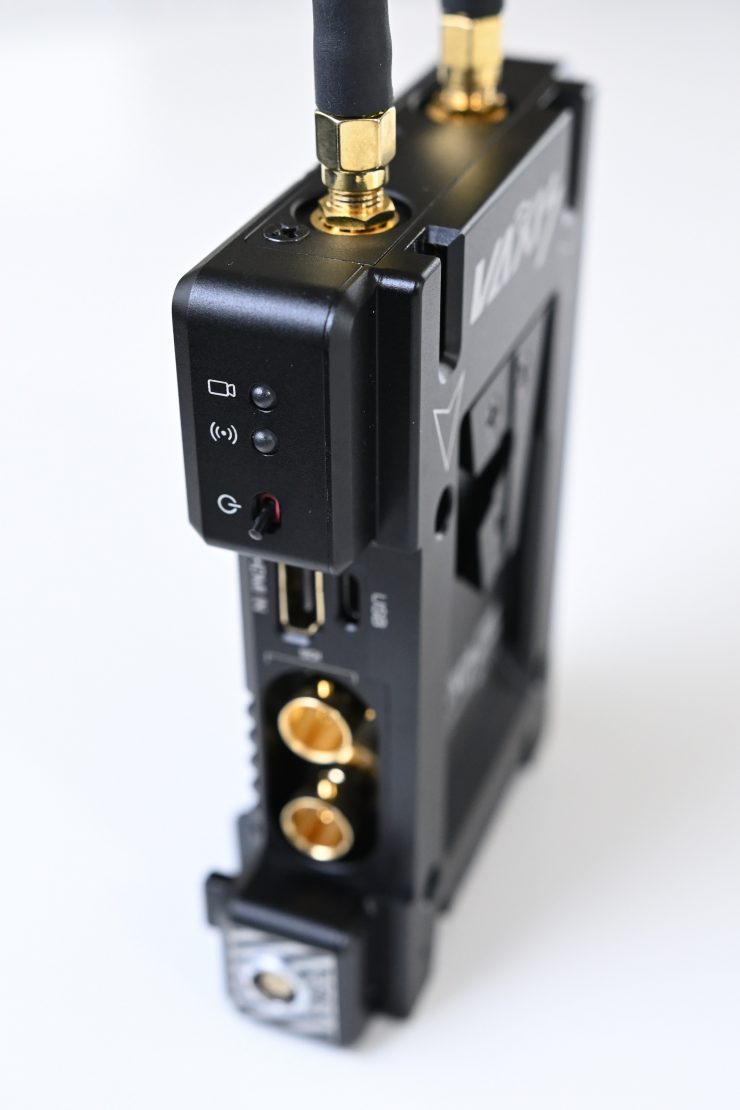
It’s certainly a solid piece of kit and it weighs in at 380 g (13.4 oz) with the two antennas attached, 296 g with no antennas. That makes it heavier than the regular Storm 3000 TX which tips the scales at 268 g (9.45 oz).
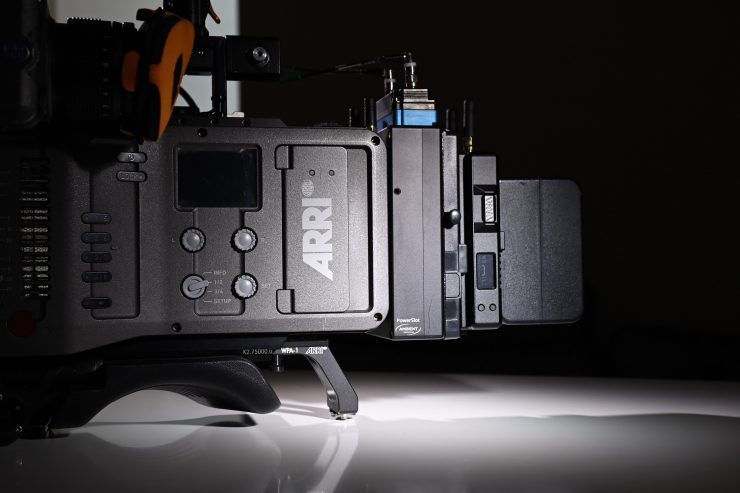
The Storm 3000 Dual V-lock TX is quite thin and once it is attached to your camera it doesn’t make the footprint that much bigger. If it wasn’t for the aerials you would hardly know it is there.
What do you get?
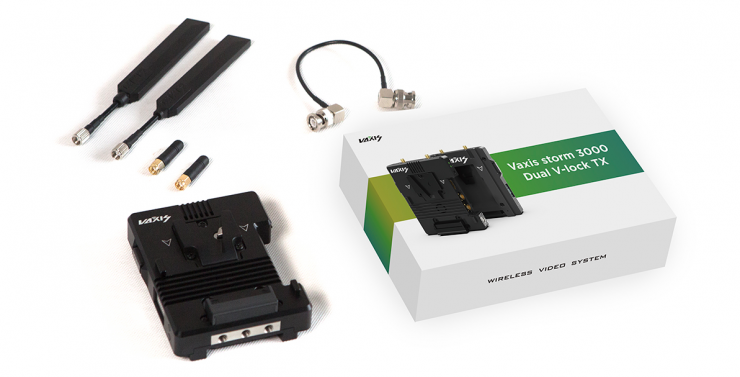
The Storm 3000 Dual V-lock TX comes with the TX unit, two sets of antennas, and a short SDI cable.
Interface
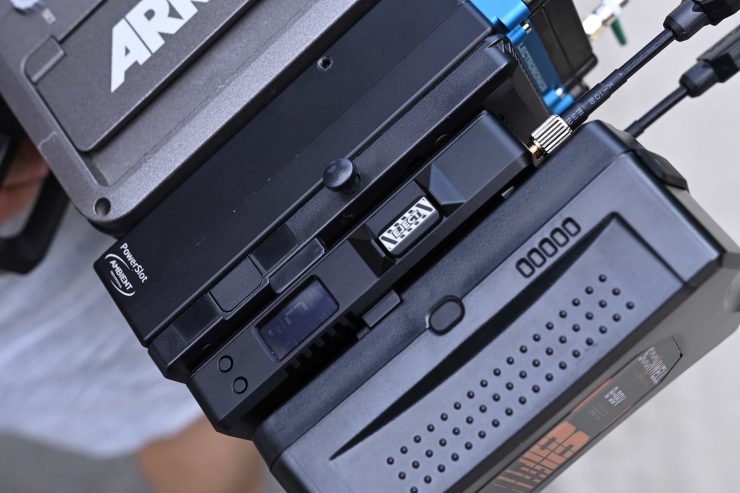
On the side of the TX, there is a control panel with an OLED screen and channel adjustment button. Up to 10 workable frequency channels can be chosen. On the OLED display, you can see indicators for wireless power status, temperature, video status, and receiver RSSI. The Storm 3000 lets you use up to 10 sets of wireless transmission suites all working simultaneously and in the same place (Multi-point to multi-point to transmit different images).
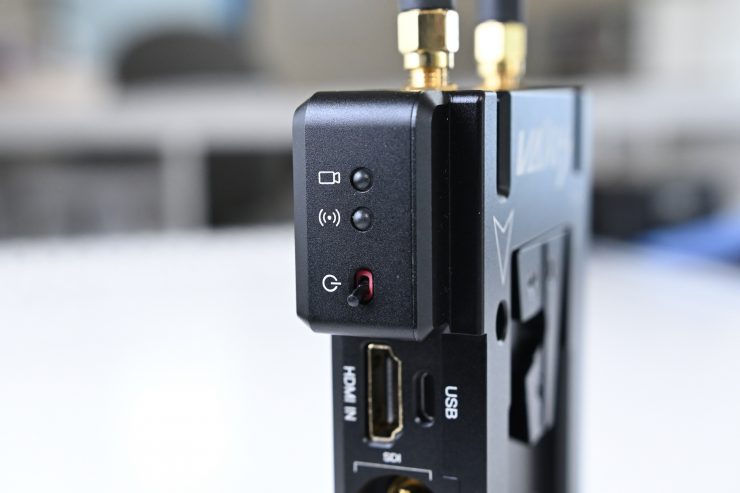
Above where the connections are there is an on/off power switch as well as to indicator lights that tell you if the unit is receiving a video signal and if it is paired with an RX unit.
Another nice feature of the Storm 3000 is that it supports metadata, timecode and run/stop control for ARRI, RED, Canon, Panasonic, and Sony cameras.
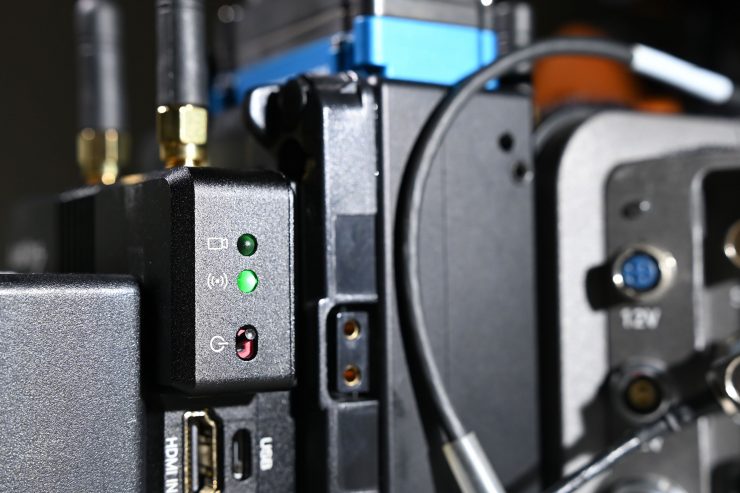
The downside to the system is because it is sandwiched between your camera and battery it will stay on unless you physically power down the TX. This is hardly the end of the world, but it does mean you have to remember to keep turning it off and on.
Two sets of Antennas
The TX comes with two different types of antennas. There is a set of small antennas and a set of larger Sword antennas.
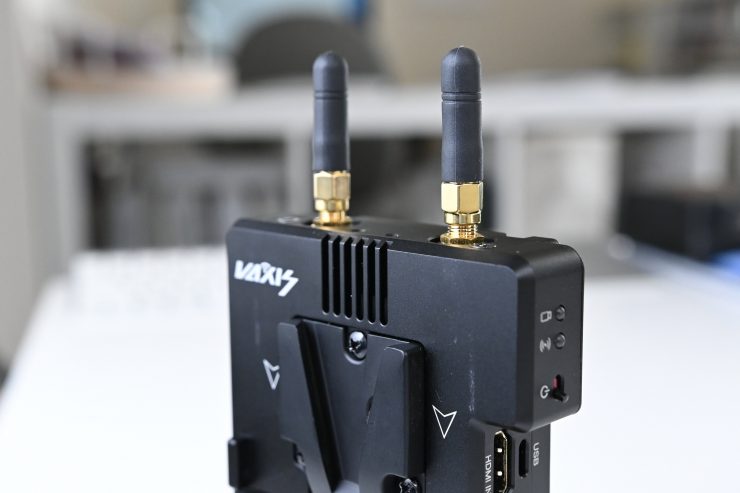
The whole idea is you can use the smaller antennas to keep the system more streamlined when you aren’t working over large distances, and then you switch to the larger Sword antennas if you need greater range or are working in an area with more RF interference.
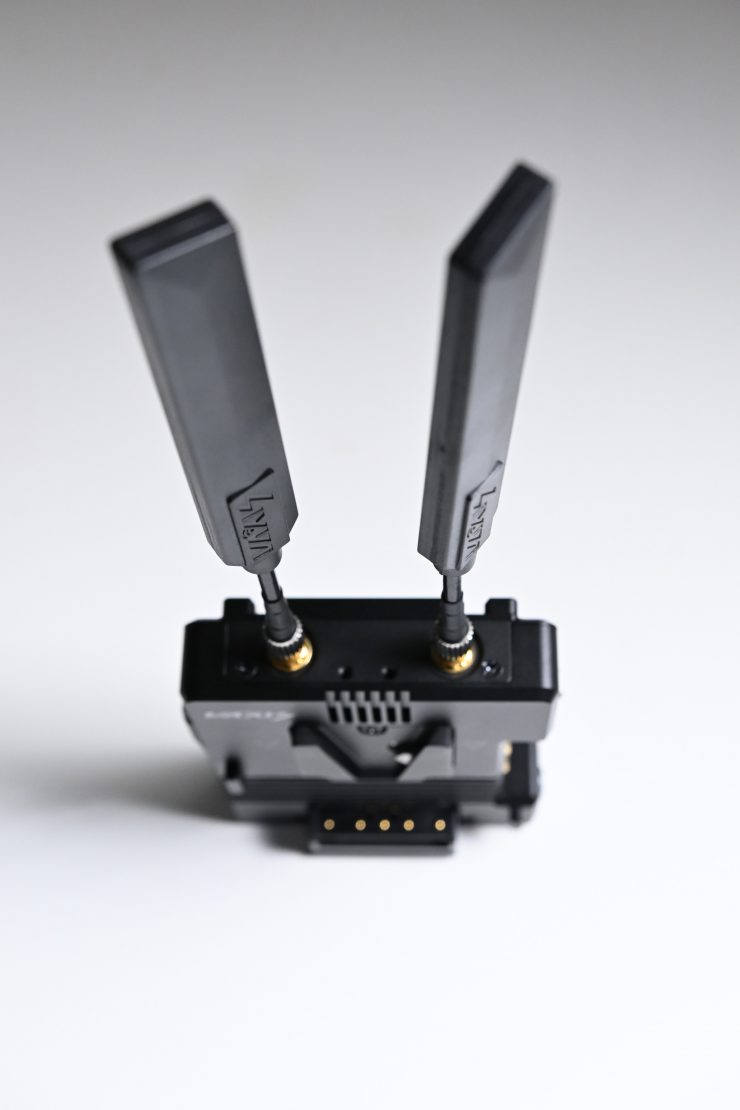
The Sword antennas look more like propellers from a drone than the type used on most other wireless devices. The reason behind this design is that it helps the antennas mitigate dBi loss from reflections because the polarization does not change when the waves reflect off surfaces. The “sword” antennas have ceramic plates inside of them that according to Vaxis, increases the signal strength. This “Sword” design was pioneered by Vaxis and now many companies such as Movcam and Kinefinity are using it.
They have also been designed to be very flexible and you can bend them around without having them break.
Mounting Points
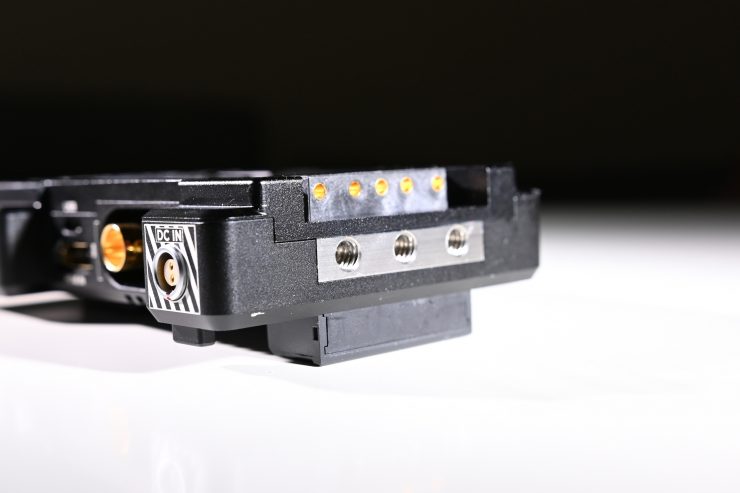
Even though the Storm 3000 Dual V-lock TX is designed to go onto a V-lock plate, Vaxis has included 3 1/4 20″ mounting holes on the bottom of the unit. This allows you to mount it somewhere else if you did want to use it on a camera that doesn’t have a V-lock battery plate.
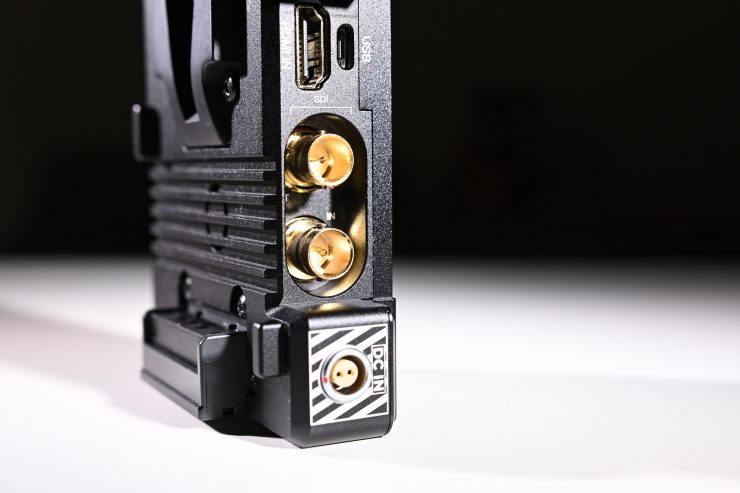
AS there is also a 2-pin LEMO DC input you can also power the TX without needing to use a V-lock battery.
Who is it aimed at?
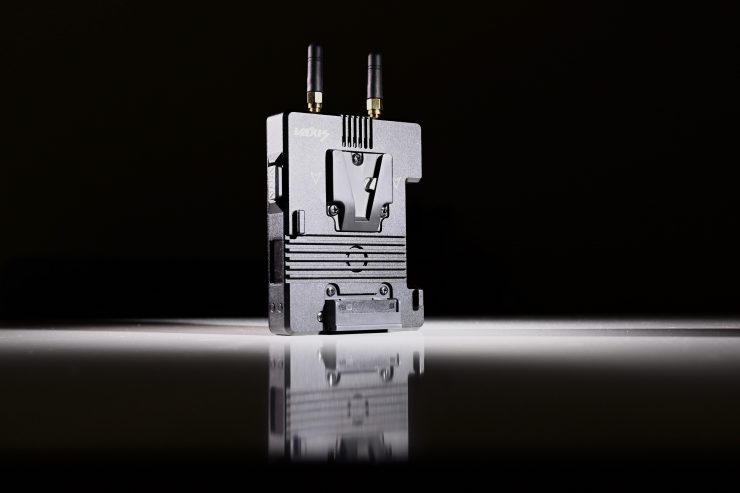
Wireless video transmission systems are a crucial part of any production. They let everyone from the director, to the producer, the focus puller, the gaffer, and even hair and makeup see what is going on. The Vaxis Storm 3000 Dual V-lock TX is part of the companies flagship wireless transmission suite and it is aimed at anyone who needed to send and receive wireless video signals over large distances.
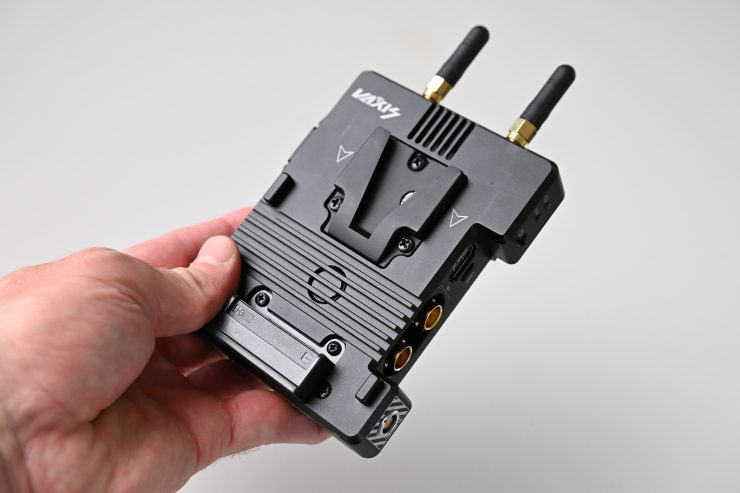
It is certainly being targeted at mid to large-sized productions where you need to be able to monitor images over large distances, but in saying that, it could easily be used by solo operators or small crews as well.
What cameras can it be used on?
You could literally use the Vaxis Storm 3000 Dual V-lock TX on just about any camera you can think of. If you are using a RED, or an ARRI, it certainly is designed to complement those cameras nicely.
Vaxis also makes a nice little V-mount plate for those who want to attach the Storm 3000 Dual V-lock TX to the side of their camera.
What can you transmit?
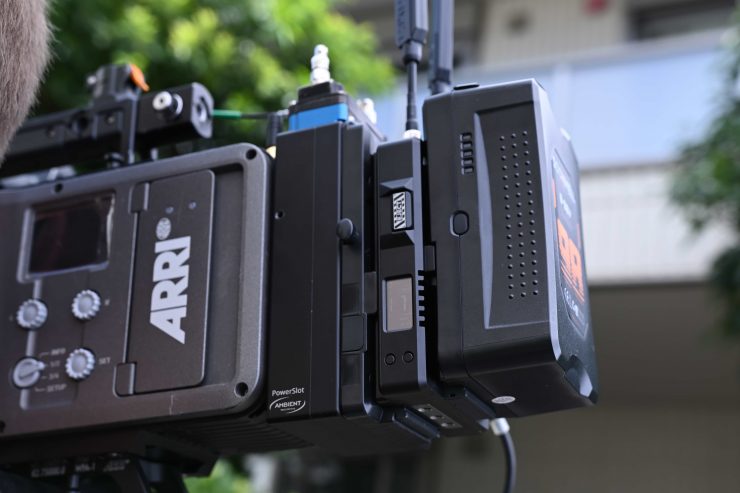
The Storm 3000 can transmit 525i, 625i, 720p and 1080p (up to 60P) signals. If both the SDI and HDMI have valid video inputs, the system will take the 3G SDI input as a priority.
Ins & Outs
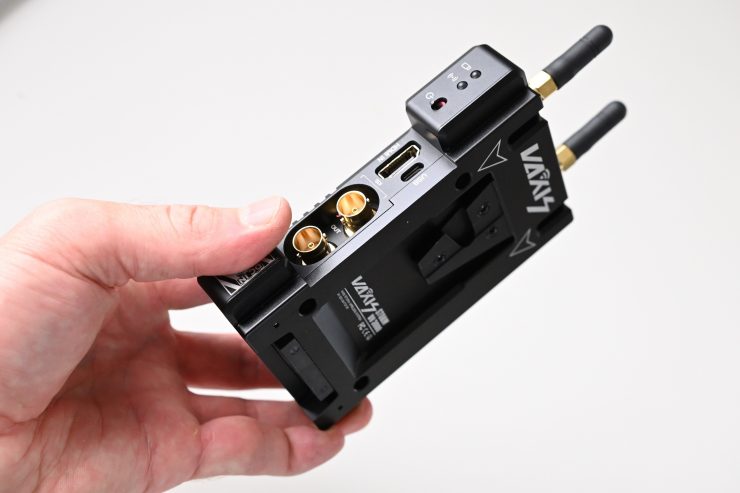
The Storm 3000 Dual V-lock TX features an HDMI In, an SDI In, an SDI Out, a USB and a 2 pin Lemo In.
Just like the Teradek Bolt 3000 TX, the Vaxis Storm 3000 TX and the RX both have an SDI loop out so if you want to connect a monitor from the same device you can.
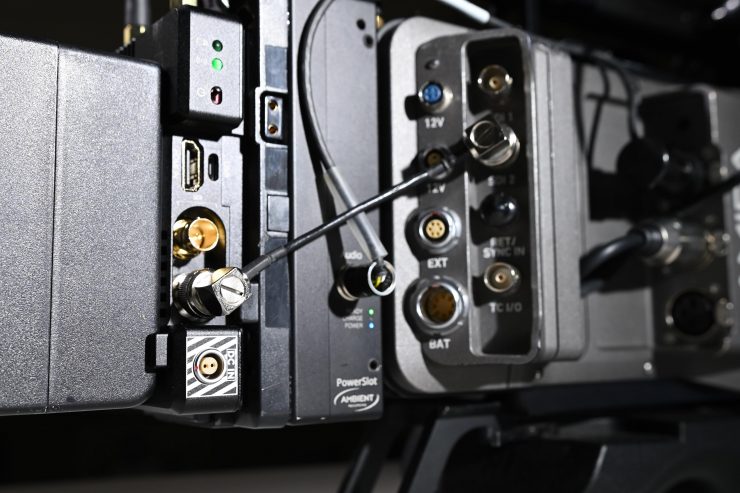
Vaxis does include an angled SDI cable, but it is very short. I would have preferred to have seen a slightly longer cable (or a coiled one) as with my particular camera set up the cable barely reached my SDI out ports.
Frequency Band
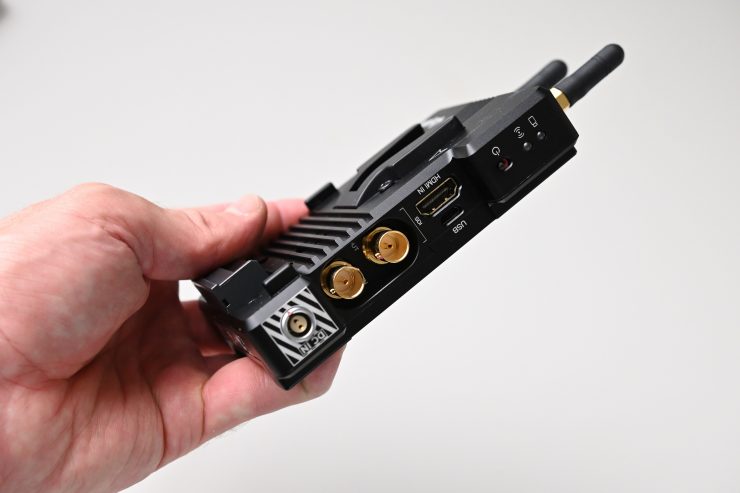
The Storm system operates on the 5.1-5.9GHz frequency band and it can be software configured to change the ISM band so that licenses can be given for it to work in different global regions. Getting certification for wireless devices can be tricky in certain countries around the world, especially Japan, Taiwan, and Korea. The Storm system has both FCC and CE approval and can be used in most parts of the world.
Encryption
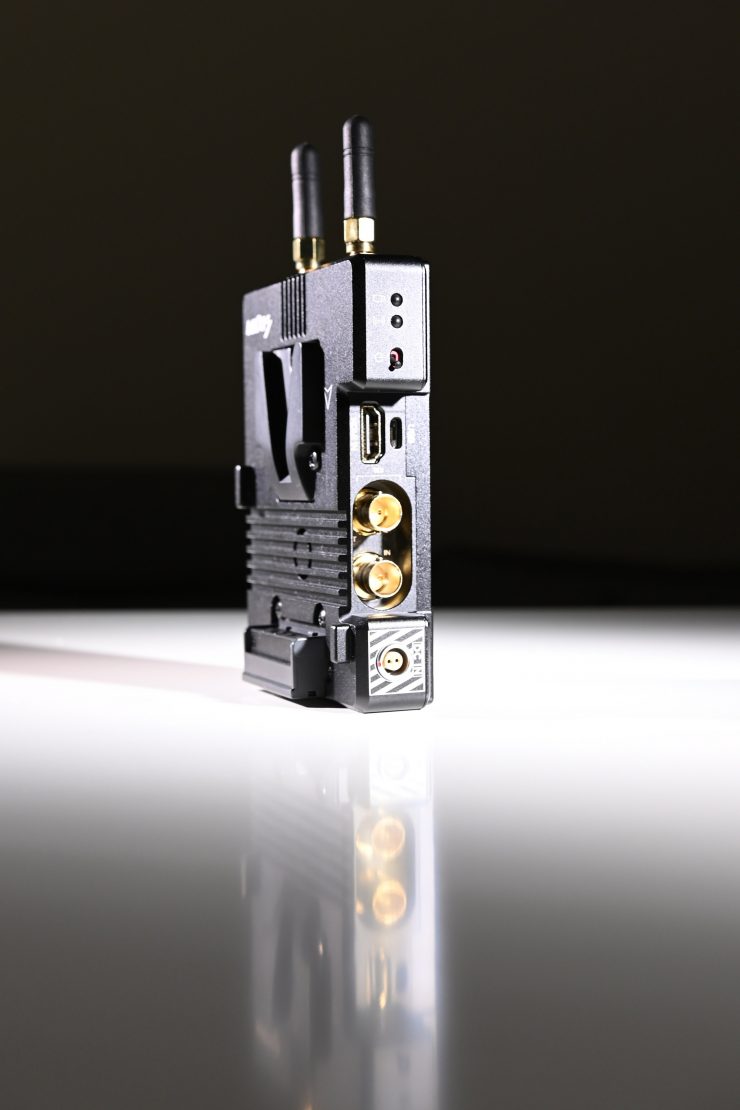
As far as encryption goes, the Storm 3000 uses AES 128 encryption. This is especially useful on larger productions where every bit of vision needs to be kept confidential and away from prying eyes, but for solo operators or small productions, it’s probably not something you are going to be worried about.
Setup & Ease Of Use
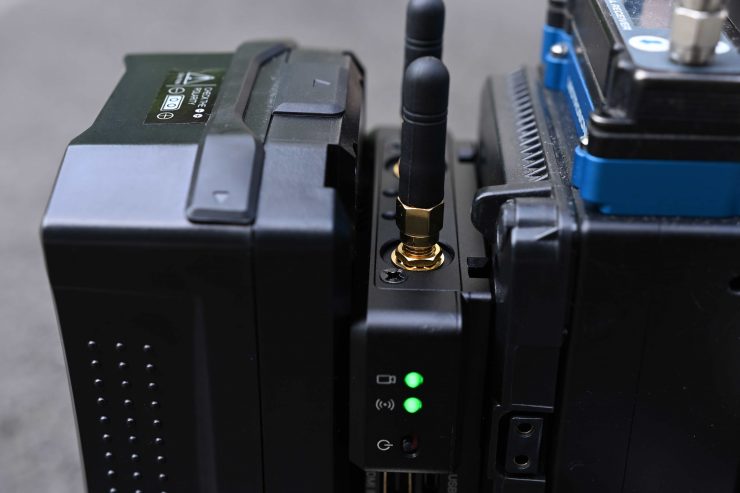
A good wireless video solution should be easy and fast to set up and get running. In all honesty, this shouldn’t be a difficult task, and if it is, then the product has already failed in my opinion.
Just like most of the Vaxis wireless systems, the Storm series is virtually plug-and-play. I placed the transmitter between my camera and battery, connected an SDI cable and then hooked up the receiver to a SmallHD monitor and turned everything on. Without having to do anything I got a picture within around 10 seconds. This is how a wireless system should be, quick and easy to use.
So far so good, but I wanted to see what would happen if I lost connection, so I turned the TX off and then back on again. It took roughly 7 seconds for the receiver to re-establish a connection which was reasonably quick.
What was strange when using the Storm Focus 058 integrated monitor and wireless receiver is that if I turned the power off on the TX unit, the Focus 058 still displays the last frozen image from the TX. This can potentially be a problem, as someone on set may not realize that you have lost the connection, especially if you are filming something that isn’t moving.
So what about if I pulled out the SDI from the camera? Again the system re-established connection in under 4 seconds.
So what would happen if I suddenly changed the frame rate to 60fps (still in a 23.98p recording mode) on my camera while the system was on? Again it took just under 4 seconds for the picture to return. When I changed the camera back to 23.98fps it also took under 4 seconds to get the connection back.
Now the Storm 3000 is claimed to support up to 60p in full HD, so I decided to test that claim. Again this was no problem at all, and the Storm 3000 receiver re-established a connection within less than 5 seconds.
In the final test, I wanted to change the operating channel and see what would happen. I changed the receiver to a different channel and then changed the transmitter to the same channel. This time it took around 20 seconds till I had a picture back.
I really tried hard to fault the Storm 3000 with all these tests, and no matter what I did the system always re-established a connection without me needing to do anything. Not once did I have to reboot both the transmitter or receiver.
Range
The Storm 3000 Dual V-lock TX is claimed to be able to transmit broadcast-class and uncompressed 3G SDI/HDMI HD video signals at distances of up to 1km (3,281 ft) with no compression and zero delay.
Compatability
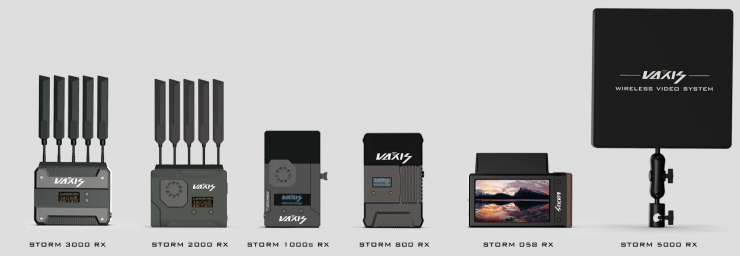
The Storm 3000 Dual V-lock TX will only work with other Storm RX units and the companies Storm Focus 058 integrated monitor and wireless receiver.
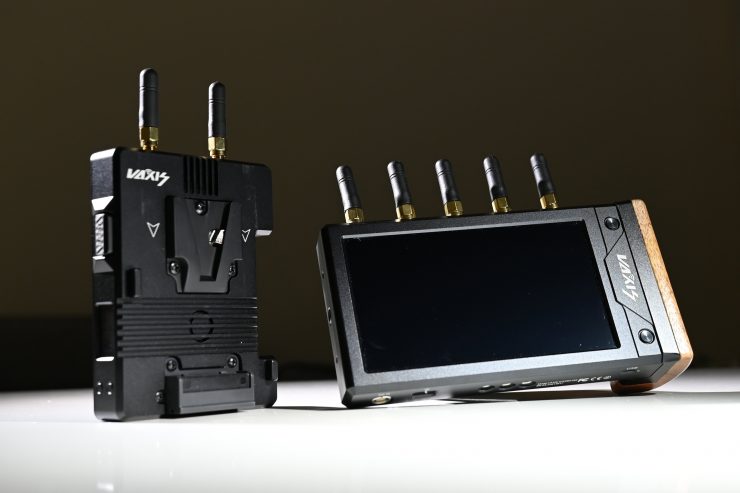
The Storm Focus 058 is an integrated monitor and wireless receiver that has been designed with convenience and ease of use in mind. Instead of having to hook up, mount, and power multiple components to create a wireless video monitoring system, Vaxis has put everything into a compact package.
The Storm 3000 Dual V-Lock TX worked really well with the Storm Focus 058 and it made for a really simple to use and convenient solution.
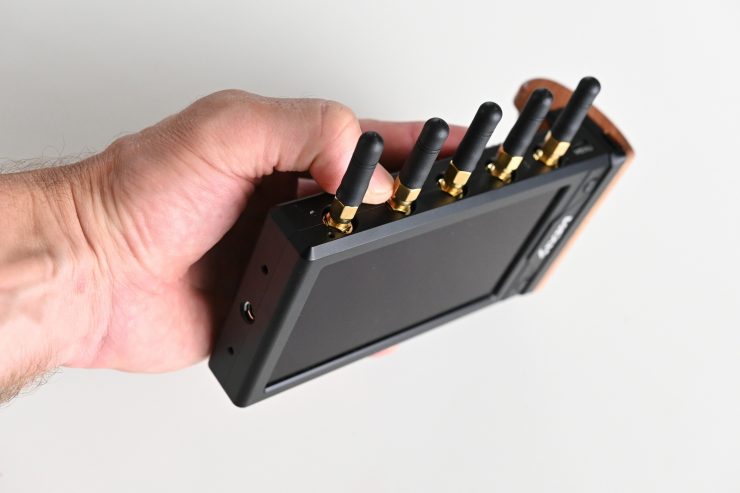
I have previously reviewed the Storm Focus 058, and while it works well as a receiver, I found it left a lot to be desired as a monitor.
Real-world performance
Pulling out connectors, changing settings and turning receivers and transmitters on and off is one thing, but how does it actually perform in the real world? Vaxis recommends that to get the best wireless transmission performance, both the transmitter and receiver need to be at least 1.5m above the ground. Keeping both the receiver and the transmitter at similar heights also helps with performance.
The real transmission distance is also relevant to the current air electromagnetic environment, because the system works in the ISM band, and therefore has exposure to all kind of 5GHz band air interference. Vaxis recommends users should do a manual frequency sweep by adjusting the frequency selection knob with a circle before using the equipment, that way you can select the best frequency channel for stable performance.

With this in mind, I decided to test the systems range and performance. To test the range of the system I remained in line of sight of the receiver and started walking away with the TX attached to the camera. I found that I could get around 230m (754 ft) before the signal dropped out. Now, Vaxis claims a maximum operating range of 1km (3,280 ft), but this is only going to be achievable on flat, open terrain where there is little wireless interference. I did this test in the middle of Tokyo which is one of the most heavily congested RF and WiFi traffic areas on the planet. I didn’t expect the Storm 3000 to reach anywhere near its claimed operating distance in this environment.
Whenever I review wireless video transmitters I do the test in the exact same place under the same operating conditions. This way I get a good idea of how various competing systems compare. Below you can see how other wireless video systems faired under the same testing conditions.
- Movcam DarkTower DT2000: 450 m (1476 ft)
- SmallHD 703 Bolt and Bolt 3000 TX: 200 m (656 ft) it’s important to note that the SmallHD 703 Bolt has a range of just 91.44 m (300 ft)
- Vaxis Thor 800ft+: 300m (984 ft)
- Vaxis Storm 3000: 400m (1,312 ft)
- Vaxis Storm 3000 Dual V-Lock TX (230m)
I can’t really explain why the Vaxis Storm 3000 Dual V-Lock TX’s range of 230m in this environment was considerably less than the result that I achieved with the regular Storm 3000 system. I didn’t have a Vaxis Channel Scanner so it may well have been down to the fact that I was on a channel where the signal wasn’t the strongest.
I did find that the receiver needed to be facing towards the transmitter and you have to be careful not to block the top of the receiver where the antennas are. If you place your hand or something over the top of this part of the receiver the signal tends to disappear fairly quickly. When the signal did disappear, I had to wait until I was back in range before it re-connected. When it did lose the connection it was able to re-establish without the need for rebooting the transmitter and receiver.
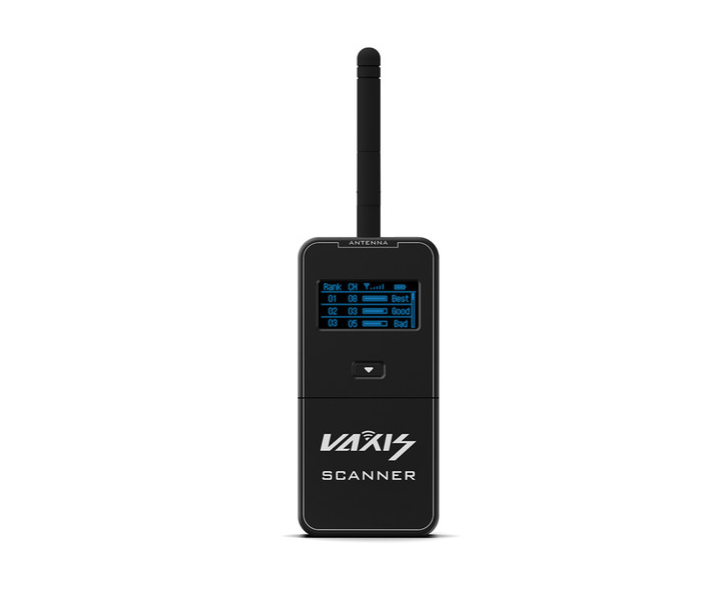
Vaxis does make an optional Channel Scanner unit ($198 USD) that you can purchase that allows users to find the least congested channel to operate the system on.
What I did like is that when you press the right button of the Storm 3000, you can open or close a new 0″ function that gives you 1 less frame delay than when it is used in regular mode. This is nice because it effectively gives you zero delay on playback when using the ARRI Alexa Mini.
Pricing and availability

The Vaxis Storm 3000 DV TX retails for $3,480 USD. The small V-lock mounting accessory is $25 USD. From the 1st to 30th August you can get 30% off this price through Vaxis global distributors/dealers.
At the promotional price of $2,430 USD, it is significantly cheaper than the competing Teradek Bolt 3000 XT TX and a Bolt Dual Battery Plate Mount which retails for a combined total of $5,880 USD.
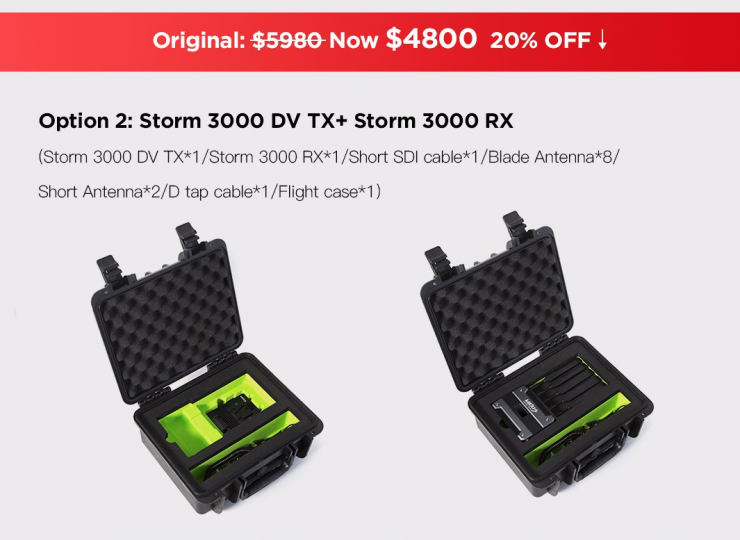
In fact, you can get a kit with a Vaxis Storm 3000 DV TX and a Storm 3000 RX for $4800 USD, which is $1,080 USD cheaper than a Teradek Bolt 3000 XT TX and a Bolt Dual Battery Plate Mount.

Also for $4800 USD, you can get a Vaxis Storm 3000 DV TX and a Storm 058 monitor kit.
The Teradek Bolt 4K 1500 is $7,990 USD but it only has a range of 1,500 ft.
Competition
The Vaxis Storm 3000 Dual V-lock TX’s competition comes primarily from the well established Teradek Bolt 3000 XT.
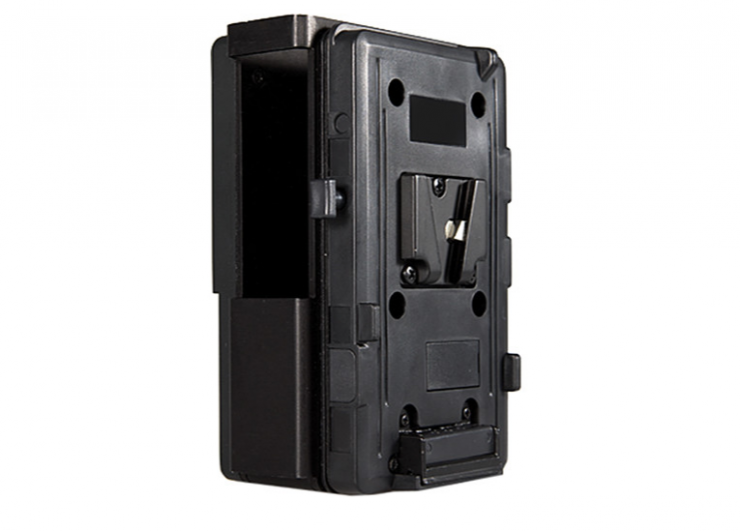
But, unlike the Vaxis solution, you need to use the Bolt Dual Battery Plate Mount with a 3000 XT to sandwich it between your camera and battery.
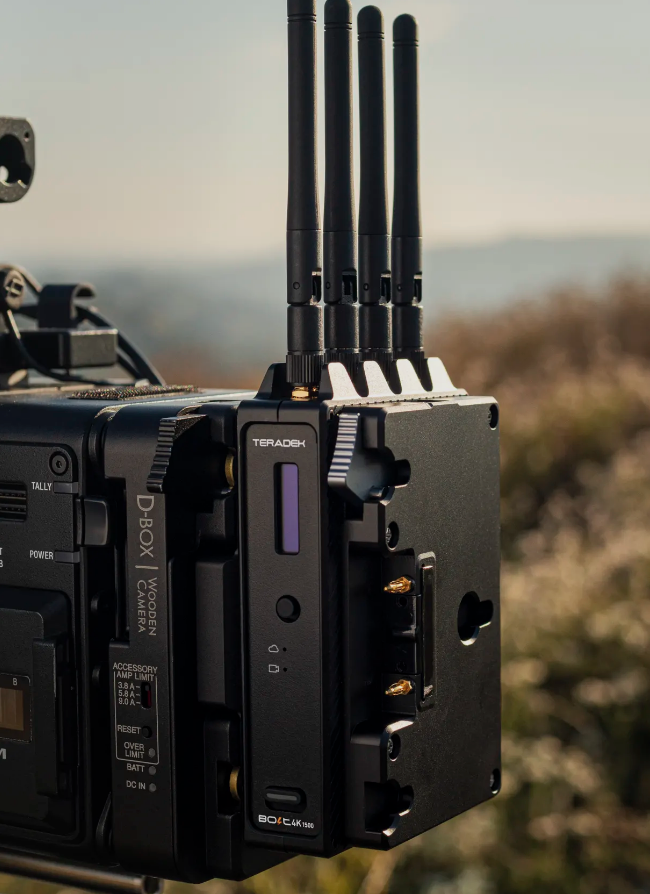
If you want an integrated Dual V-lock battery plate solution from Teradek that doesn’t involve an additional battery plate mount, they do have the Bolt 4K.
So let’s just compare the Teradek Bolt 3000 XT to the Vaxis Storm 3000.
| Teradek Bolt | Vaxis Storm 30000 Dual V-Lock TX | |
| Range | Up to 3000ft line of sight | Around 1km (3280 ft) |
| Built-in HDMI to SDI Converter | Yes | Yes |
| Power Consumption | 8.5W | <6W |
| Audio Compression | 48kHz 24-bit PCM | 48kHz 24-bit PCM |
| Wireless Frequency | US: 5.19 ~ 5.23 GHz and 5.755 ~ 5.795 GHz EU & JP: 5.19 ~ 5.23 GHz DFS Frequencies: US: 5.27 ~ 5.55 GHz and 5.67 GHz EU & JP: 5.27 ~ 5.67 GHz (20MHz and 40MHz channels) | 5.1-5.9GHz |
| RF Power | 17dBm EIRP | Maximum 21dBm |
| Maximum Supported Resolutions | 1080p60 | 1080p60 |
The Teradek Bolt 3000 XT also has features such as backward compatibility with any Bolt of the same range, Sidekick II / LT / XT, and 703 Bolt. It also uses a unique AES 128 encryption algorithm to protect your video footage. It also uses Teradek’s proprietary software utilities, including a manual frequency-selection tool, 3D LUT engine, and a 5GHz spectrum analyzer to keep an eye on interference in your area.
What you also need to keep in mind is that Teradek units are everywhere and they are stocked by rental houses all over the world. What this means is that you happen to have a problem or need a replacement unit you can get one very quickly. If you have a problem with the Vaxis Storm 3000, you are going to struggle to find a replacement in a lot of places in the world. While more Vaxis products are starting to be used, the numbers of units in circulation are still small if you compare it to Teradek.
Conclusion
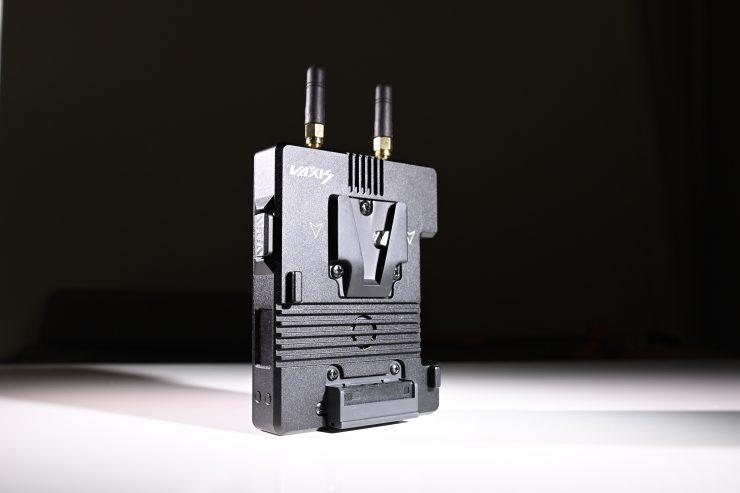
A wireless video transmission system needs to have rock-solid reliability. It also has to not get in your way and be easy to set up and use.
From my time testing the Storm 3000 Dual V-lock TX and Storm 3000 RX I found it to be very reliable and easy to use system, even over large distances.
I like its compact design and the way it seamlessly becomes part of your camera. It’s nice that Vaxis has designed the TX unit so you don’t have to sandwich it between a camera and a battery if you don’t want to.
I’ve been very happy with the reliability of Vaxis wireless systems. I am yet to have a problem using any Vaxis system on any of my shoots. They have always been reliable and rock solid.
The unit does face very stiff competition from the Teradek Bolt 3000 XT., and probably more so from the yet to ship Bolt 4K. Teradek is almost an industry standard, and it is the often the main wireless video system you see on high-end productions. Selling lower-end wireless video systems is a lot easier, but once you get up to the high-end, people tend to go with established brands that they know. Let’s hope this changes because the competition is good for everyone.
With the current introductory discounts, the Vaxis Storm 300 Dual V-lock TX offers very good value for money.
The Vaxis Storm Storm 3000 Dual V-lock TX does exactly what it’s supposed to do and it does it with minimal fuss. It’s solid, reliable and gets the job done, and really, that is all you can ask from any product.

